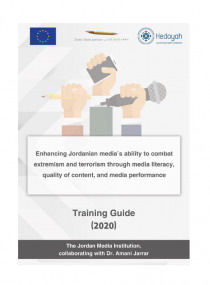
On Tuesday, the Jordan Media Institute (JMI) hosted director Mohammed Alatar. Alatar spoke to JMI students about a study he conducted, titled “The image of the Palestinian in American media – Time weekly magazine as a model”. The study monitors Time’s coverage of the Palestinian issue between 1946-1990.
Alatar showed that Time – the most widely distributed weekly magazine globally – began addressing the Palestinian issue in August 1946. On the magazine’s cover in that month, an image was published which was reflective of its vision regarding the Arab Israeli conflict and which it tried to convey to the American reader. The image represented Palestine as “the promised land” being a focal point to the world as it awaited the “Jews” who were supposedly promised said land.
Alatar explained that he used the theory of media framing in his analysis of Time’s content, a content that is biased in favour of the Israeli perspective and which contributed to framing Palestinians negatively. This negative portrayal began by presenting the Palestinians with more than one name or identity. This chaotic introduction was deliberate and included messages the magazine wanted to convey to the American readers generally and especially the political elite. It is worth noting that the political elite are main readers of the magazine and are influenced by it.
Alatar affirmed that Time magazine has repetitively invested in an image’s power to make an impact, and deliberately provide a negative image of Palestinians, in juxtaposition to a positive image it skilfully created for the Israeli side and its political leaders.
Alatar mentioned that the 1982 Beirut invasion generally and the Sabra and Shatilla massacre specifically, were a turning point in how Time magazine addressed the Arab Israeli conflict. Here for the first time in its history, the magazine started to present a different picture of the Israeli side, utilizing unprecedented language, such as when it described the former Israeli PM Menachem Begin stating that “he lied to us repetitively and deliberately”.
On the other hand, Alatar explained that the Palestinian intifada which began in late 1987 forced Time to make a tangible change in how it covered the Palestinian issue. Accordingly, the magazine started to present the Palestinian side with a different language and in a positive light, which in turn contributed to bringing the Palestinian issue back to the forefront in the international political arena. He pointed out that this phase could be called the era of Palestinian absorption in American media.
At the conclusion of his lecture, Alatar called on JMI students to exert extra efforts in producing distinctive media content which could contribute to changing Western perspectives of Arabs and improving the Arab image in American and Western media. He also stressed the significance of the students diversifying their research fields, to include for example analysing the content of Newsweek magazine and the image of the Arab in it.



